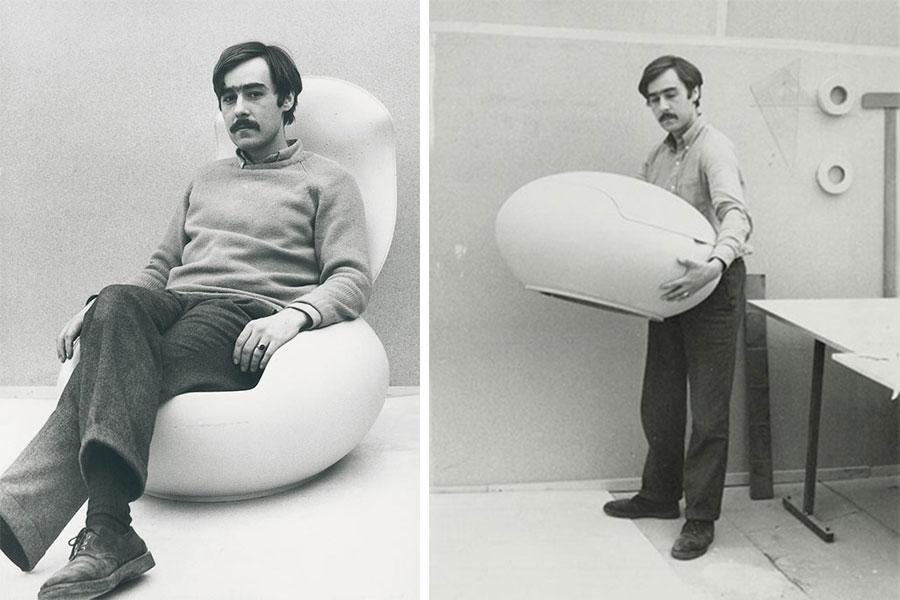We, ‘BOLD-people’, love stories and histories. So we dove into the internet archives to track down more information about our Garden Egg Chair and its designer, Peter Ghyczy.
Ghyczy was child of an aristocratic family and grew up in Buda, a district of Budapest. After the invasion of the Red Army in 1945, in which his father was killed, he was sent to the family's property Vásárosnameny in the Puszta plains. In 1947 he was brought to Belgium by the International Red Cross for one year, where he learned French.
After the family was expropriated of their estate, he returned to his mother in Budapest. In 1956, after the crushing of the Hungarian uprising against the communist regime, he fled with his mother and brother via Vienna to Bonn.
In 1967 he graduated as an architect in Aachen with a thesis on unconventional school buildings. In 1968 he was chief designer for the Polyurethane factory 'Elastogran GmbH' in Lemförde (West Germany). He was responsible for setting up the Design department, developing polyurethane products. One of his very first designs was the so called 'Garden Egg' chair in 1967. The design incorporates features typical of the period: a space-age look, UFO-like form, bright coloured plastic laquer, portability and the informal lounging quality of the low seat.
Behind the story of the chair's mass production also lies a fascinating tale of east-west relations. The company in Lemförde produced only a couple of chairs while testing the new material polyurethane. The lacquering process required substantial manual labor, making mass production too expensive for West Germany. The company then transferred mass production to East Germany. Although such a decision was not unique, official industrial exchange between capitalist West Germany and socialist East Germany was not acknowledged.
The license to produce the chair was sold to the VEB Synthesewerk Schwarzheide close to the city of Senftenberg. Officially, one third of their production was for the West German market, the rest for East Germany and for export. The production of the chair stopped after only 2 or 3 years as the lacquering remained problematic, yet the chair became an iconic 'east' German product, due to its popularity in trade shows and exhibitions. As Garden Egg Chairs were expensive both to make and sell, production was halted in 1975.
In an interview former general director of the VEB Synthesewerk-Schwarzheide, Dr. Hans-Joachim Jeschke said the chair was seen as a mere fashion article and as such far too expensive with a sales price of 430 marks, comparable to a general salary: “No one in the company knew the designer’s name or was specifically interested in the chair.” But the production manager of the VEB Synthesewerk, Günter Dämmig, calls Jeschke’s assertion into question. Dämmig confirmed that he knew the designer’s name, Peter Ghyczy, but had not been allowed any contact. Moreover, most VEB workers, Dämmig averred, were proud to be involved in its production because they regarded all production for the West as something special. Moreover, East German consumers, according to Dämmig, happily paid the high price for the chair as they construed getting one with ownership of a Western product. It was not necessarily the price but the limited space of their dwellings that restrained many from buying one, as only people with a house and/or yard had a suitable place for such a chair.
In 1990, when the first West German garden stores opened on eastern territory, East Germans discarded a large number of original Garden Egg Chairs in favor of new and cheaper West German versions. Apparently, the chair they had previously associated with the West was no longer Western enough in light of reunification, having been produced in the East long before that. Yet, just a few years later, Garden Egg Chairs became sought-after collector’s items. Owners in East and West lucky enough to have them guard them carefully and place them in prime locations.
Prototypes were manufactured in West Germany, but it was mass-produced in East Germany. And it is now a collector’s item because it finally became what it aspired to become at its outset: a design icon of its time. BOLD is proud to have one in stock. If you would like more information about our piece, do not hesitate to contact us.
(we owe a lot to http://www.vam.ac.uk/content/articles/g/the-garden-egg-chair/ for the content of this article, many thanks for the interesting information)

Peter Ghyczy and his Garden Egg Chair